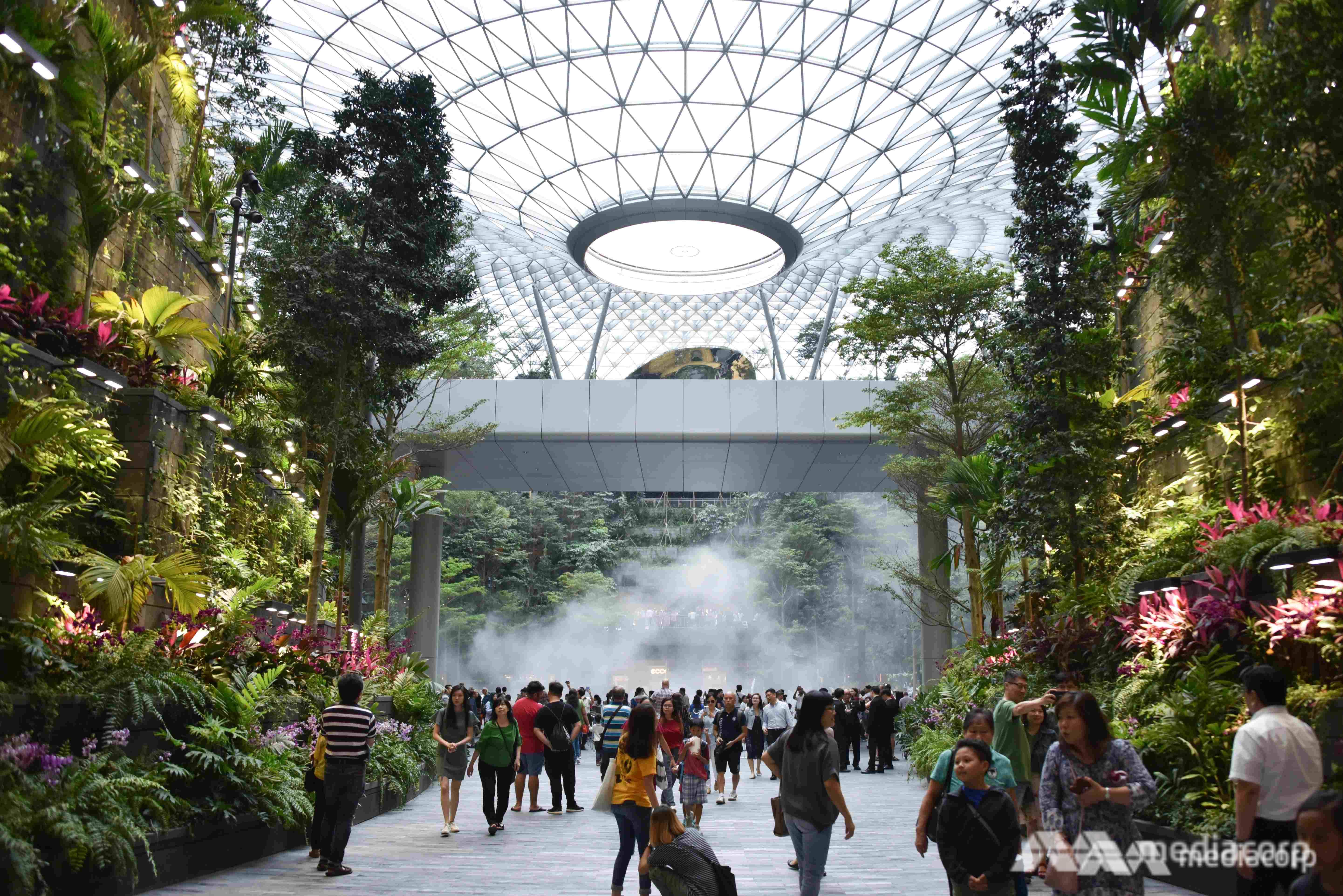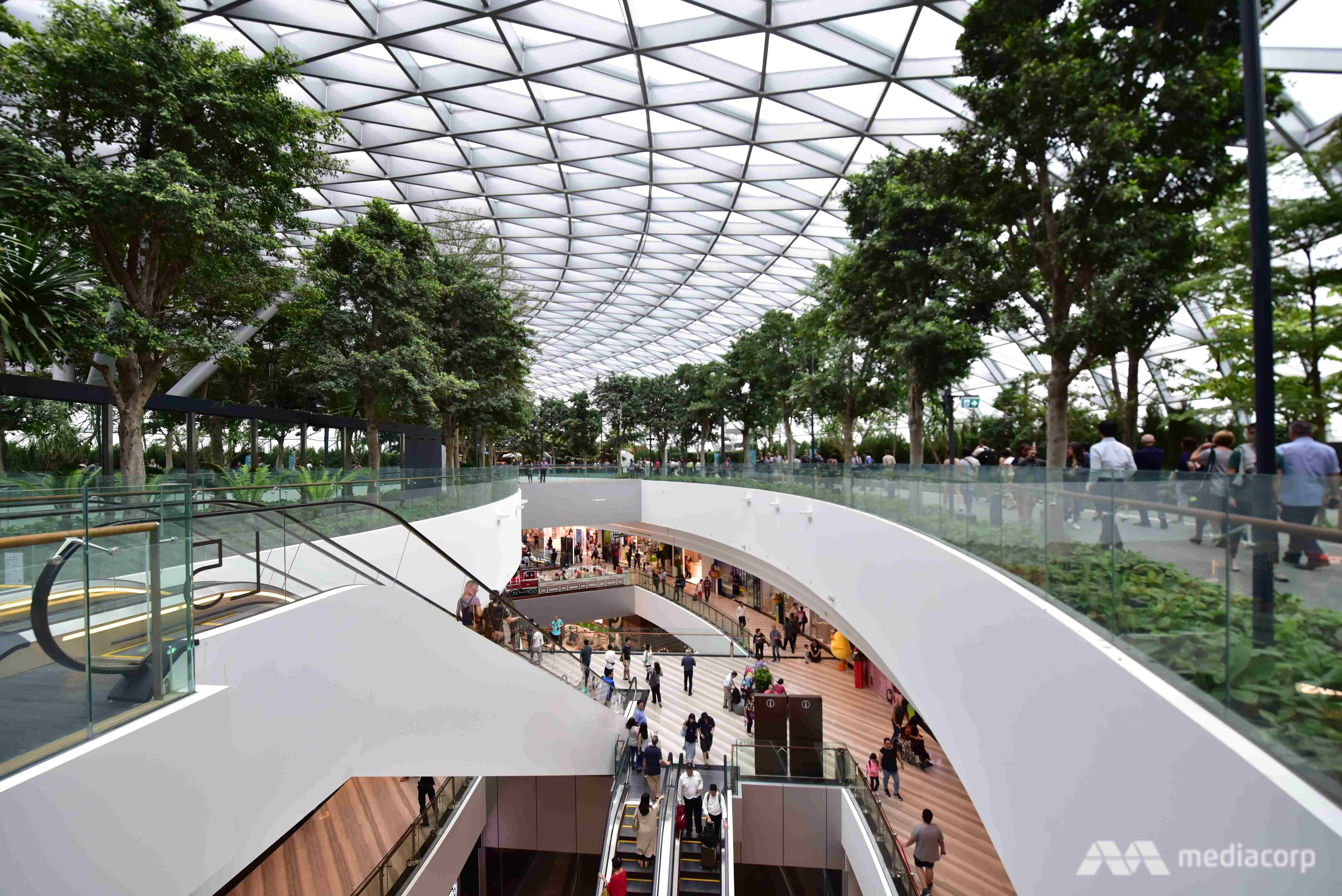SINGAPORE: Taking a leaf out of ancient scriptures and literature, world-renowned architect Moshe Safdie said on Friday (Apr 12) that Changi Airport’s new lifestyle destination, Jewel, was modeled after a “mythical garden”.
“The idea of a garden, well, Singapore has all kinds of gardens (like) Gardens by the Bay (and) Botanical Gardens. How do we do something unique and special? And I was thinking of (the) gardens of ancient scriptures, literature. Every culture has its own gardens of paradise. More recently, the landscape in the Avatar film, in the sense that this was a place we (have) never seen before,” he told CNA.
Mr Safdie, who also designed Marina Bay Sands, said that he had the idea of creating “a great place of nature” in the heart of an airport, with a marketplace that is “intense and busy” on one side, and a nature reserve just adjacent.
The design brains behind Jewel Changi Airport, Moshe Safdie, in front of the Rain Vortex. (Photo: Gaya Chandramohan)
“We recognised from the outset that the bazaar, marketplace, and the garden need to cohabit, but be separate. Each is in its own environment and in its own right,” he added.
He shared that he had the task of designing a facility that unified Changi Airport’s Terminals 1, 2 and 3, and to serve the passengers and the city. This, Mr Safdie added, would mean shopping and airport facilities, as well as an attraction.
“So naturally, everybody thought, ‘Wow (an) attraction! Let’s have dinosaurs, let’s have mummies, some kind of a thematic thing’. And we, as the architects in the room, resisted this notion of an attraction, which would not have brought traffic, (and) which (would) appeal to one age group and not another,” he said.
READ: In pictures: First look inside Jewel Changi Airport
RAIN VORTEX AS THE CENTREPIECE
“I’ve always been fascinated with the capacity of a building to collect rain and bring it into the building and use that water. Here was a great opportunity – a vast dome that covers the entire side, which if we turn it in on itself rather than a conventional dome, it would bring all the water right into the centre,” said Mr Safdie.
“But then we thought, what if we hang it out there instead of supporting it with a column, it would be an amazing waterfall.”
That waterfall forms the centrepiece in Jewel. The 40m HSBC Rain Vortex is also the world’s tallest indoor waterfall, with water falling through the roof at a velocity of 10,000 gallons per minute. During the light and sound shows in the evening, this is reduced to 1,500 to 2,000 gallons per minute.
That water is then circulated through pipes concealed within the building. A water tank with a 500,000L capacity and the control room is stored at basement 3 of Jewel.
The Rain Vortex in Jewel Changi. (Photo: Gaya Chandramohan)
SINGAPORE CLOSE TO MY HEART: SAFDIE
Mr Safdie said that designing Jewel ranked a nine out of 10 in terms of the difficulty of technical issues, but he was not fazed by the challenges and is glad to have completed this job.
“Eight, nine, doesn’t really matter. It’s complex, very complex,” said the 80-year-old Israeli-Canadian architect. “My team must feel terrific.”
Mr Safdie said he has been working on projects in Singapore as far back as 40 years ago, and said some of his “most significant” work is found here.
His other work includes the Sky Habitat condominium in Bishan.
“It’s certainly been a place where there’s been receptivity to my architectural ambitions and interests. I also find that the process of building here, the approval process, the review process, is very rationale and very professional,” said Mr Safdie.
READ: Throwback Thursday: The taste of nostalgia lures snaking queues of A&W fans on opening day
Moshe Safdie, the architect behind Jewel Changi Airport, leading journalists on a tour of the attraction. (Photo: Gaya Chandramohan)
CHALLENGES OF DESIGNING JEWEL
While he had the scope to exercise his creativity, Mr Safdie said there were some challenges he had to contend with when designing Jewel. One of those challenges was the height restrictions of the development.
This was due to the constraints of constructing a building next to iconic control tower. Jewel stands at 37.08m tall from the ground up.
“There is a very specific line of the radar (that) we could not exceed,” he said. “Otherwise, we would have gone taller because of the curvature of the dome.”
Other considerations included the flow of people from the existing terminals, as well as the Skytrain tracks that were already built. The latter resulted in Jewel being built around the tracks, which he said caused “a dilemma” on whether to enclose the train tracks or to leave them out in the open.
READ: Jewel Changi Airport opens its doors to first visitors

Visitors were captivated by the lush greenery and serenity of the cascading waterfall. (Photo: Gaya Chandramohan)
“It took us a year to work out the scheme, (in) which we would get the trains to run in the open by having to devise a method of locks (on each end of the track) that keep the air inside the building and don’t let us lose energy. (Because) this building has to meet the highest environmental standards,” he added.
His biggest challenge was to create a space that was “good for the trees and good for people, where the climate needs to do both”.
“This balancing act, making the plants thrive, making them feel happy, have enough moisture … that took a big team, (an) international team of experts in many fields and this was like orchestrating an opera with a lot, a lot of players,” he explained.
Mr Jeremy Yeo, head of user experience for Jewel Changi Airport Development, previously told CNA that there are 120 species of plants in the Shiseido Forest Valley, five per cent of which are local. They include ferns and orchids.
He highlighted that the temperature in the Forest Valley is a constant 23 degrees Celsius, and that specially curated plants include two olive trees from Spain that are more than 100 years old.

Jewel offers a multi-faceted experience of integrated nature, shopping and dining concepts. (Photo: Gaya Chandramohan)
When asked if there were some concerns that Jewel was another airport mall, Mr Safdie said that his team “did everything (they) could to resist making an airport mall”.
“It is an airport mall, but (we are) juxtaposing it next to the garden (Forest Valley), bringing in a lot of daylight everywhere, from above. When you are walking in the shopping arcades, you are conscious of the trees above,” he said. “We really tried to make this more like a shopping street in a city, than a mall.”




